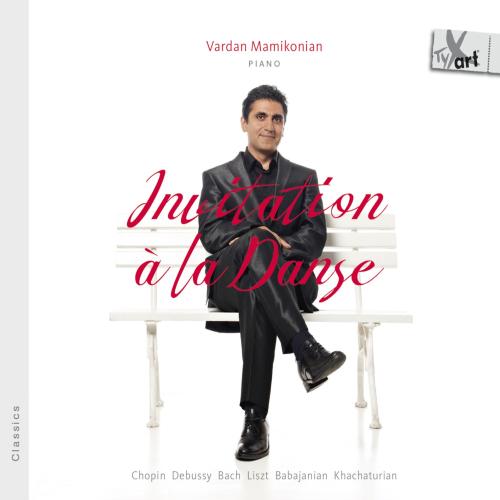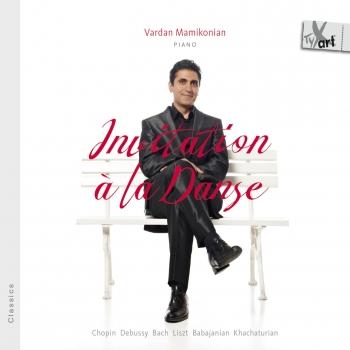
Invitation à la Danse – Works for solo Piano by Chopin, Debussy, Bach, Liszt, Babajanian & Khachaturian Vardan Mamikonian
Album info
Album-Release:
2024
HRA-Release:
16.05.2024
Label: TYX Art
Genre: Classical
Subgenre: Instrumental
Artist: Vardan Mamikonian
Composer: Johann Sebastian Bach (1685-1750), Frederic Chopin (1810-1849), Claude Debussy (1862-1918), Franz Liszt (1811-1886), Arno Babadschanian (1921-1983), Aram Khachaturian (1903-1978)
Album including Album cover
- Johann Sebastian Bach (1685 - 1750): Partita No. 2 in D Minor, BWV 1004:
- 1 Bach: Partita No. 2 in D Minor, BWV 1004: Chaconne for Solo Violin (arranged for Piano by Ferruccio Busoni) 13:52
- Frédéric Chopin (1810 - 1849): Andante spianato et grande polonaise brillante, Op. 22:
- 2 Chopin: Andante spianato et grande polonaise brillante, Op. 22 13:41
- Mazurka, Op. 33 No. 4:
- 3 Chopin: Mazurka, Op. 33 No. 4 04:44
- Claude Debussy (1862 - 1918): Estampes, L. 100:
- 4 Debussy: Estampes, L. 100: II. La Soirée dans Grenade. Mouvement de Habanera 05:04
- La Plus que Lente (Valse), L. 121:
- 5 Debussy: La Plus que Lente (Valse), L. 121 03:50
- Franz Liszt (1811 - 1886): Rhapsodie Espagnole (Spanish Rhapsody), S. 254, R. 90:
- 6 Liszt: Rhapsodie Espagnole (Spanish Rhapsody), S. 254, R. 90 13:30
- Arno Babajanian (1921 - 1983): Vagharshapat Dance (Komitas):
- 7 Babajanian: Vagharshapat Dance (Komitas) 01:52
- Aram Khachaturian (1903 - 1978): Ballet Gayaneh:
- 8 Khachaturian: Ballet Gayaneh: Sabre Dance (arranged for Piano by Vardan Mamikonian) 02:59
Info for Invitation à la Danse – Works for solo Piano by Chopin, Debussy, Bach, Liszt, Babajanian & Khachaturian
"I have devoted this most recent recording to dance. The pieces that I perform here are all linked to the art of dance from different eras and different cultures. Throughout history and in most people's perception, dance has always been a source of entertainment and joy, but it can also represent more sombre occasions, with pomp and grandeur.
The Chaconne, for example, has become both tragic and sublime over time and today its rhythm has mellowed!
Chopin's Mazurkas can be rustic and folkloric, haunting or lyrical, even dramatic. In short, dance can express diametric opposites and unite those opposites at the same time.
That's why I also want to pay homage to Shiva's dance, for this god, the symbol of destruction, illusion and ignorance, destroys in order to awaken human beings and lead them to create a new world.
Shiva's divine dance, Tandava Nritya, is regarded by Hinduism as the origin of the cycle of creation, preservation and devastation.
Vagharshapat Dance is based upon a melody from 'Yerangi’ found in “Six Dances for Piano” (1906) by the legendary Armenian composer Komitas (1869–1935). Vagharshapat is the location of Etchmiadzin Cathedral and the fourth largest city in Armenia located 11 miles west of Yerevan.
My recording ends with Khachaturian's "Sabre Dance", in an arrangement of my own. The duality of this piece's character is obvious, as while the sabers suggest the idea of death, the dance becomes a 'living dance', one that enchants us or, a dance that comes alive.
I hope that the current times of wars, destruction and social upheaval will soon be replaced by peace and the joy that comes with it, and I hope that this recording brings a form of respite and quietude and with it lightness, joy and happiness." (Vardan Mamikonian)
“Mr. Mamikonian demonstrated a technique that combines power and gracefulness, an ear for stylistic nuance and flashes of interpretive ingenuity." (Allan Kozinn, New York Times)
Vardan Mamikonian, piano
Vardan Mamikonian
hat sich dank seiner prestigeträchtigen Technik und seiner außergewöhnlichen Musikalität in die Aufmerksamkeit des Publikums und der internationalen Presse gespielt.
Er konzertierte in den USA mit renommierten Orchestern wie den Atlanta, San Francisco, Detroit, Pacific, Houston und National Symphonies sowie mit dem Los Angeles Philharmonic Orchestra im Hollywood Bowl, und ist Gast bei den größten internationalen Festivals wie Verbier und St. Moritz (Schweiz), Ravinia (USA), La Roque d‘Anthéron (Frankreich), dem Schleswig-Holstein Musikfestival (Deutschland), und dem Hong-Kong Arts Festival. Der Pianist gibt Recitals in den renommiertesten Musikzentren: Musikverein Wien, Carnegie Hall New York, Théâtre des Champs-Élysées Paris, Herkulessaal München, Wigmore Hall London, Tonhalle Zürich, Davies Symphony Hall San Francisco und Kennedy Center Washington, um nur einige zu nennen.
Vardan Mamikonian wurde in Jerewan, Armenien, in eine Musikerfamilie hineingeboren und begann sein Klavierstudium an der Spendiarian-Musikschule seiner Heimatstadt unter der Leitung von Arkui Haroutunian. Er setzte seine Studien an der Zentralen Musikschule in Moskau sowie am renommierten Tschaikowsky-Konservatorium bei Valery Kastelsky, einem der letzten Schützlinge des legendären Heinrich Neuhaus, fort. Anschließend vervollkommnete er sein Können an der Klavierakademie in Imola, Italien, unter der Leitung von Lazar Berman. 1991 zog Vardan nach Paris und 1992 gewann er die World Music Masters Competition in Monte Carlo, welche ausschließlich Preisträgern internationaler Wettbewerbe vorbehalten ist. Vardan Mamikonian hat an zahlreichen Aufnahmen für Radio und Fernsehen sowie für das deutsche Label Orfeo mitgewirkt. Mehrere seiner Einspielungen wurden von der Fachpresse weltweit hochgelobt.
This album contains no booklet.










